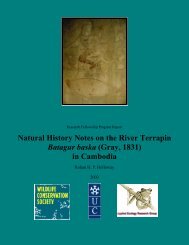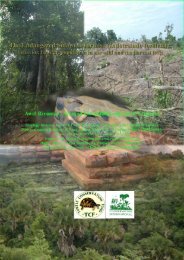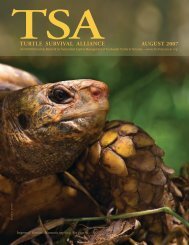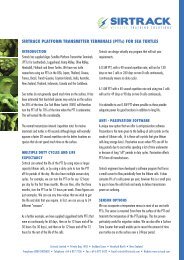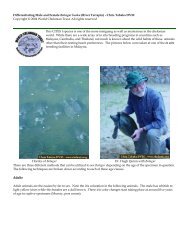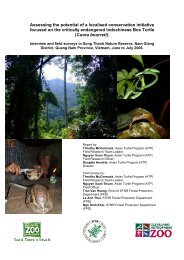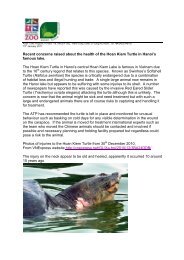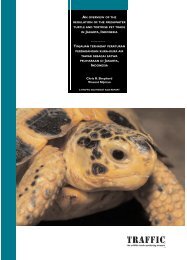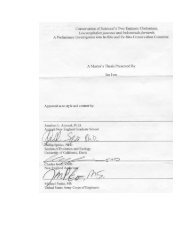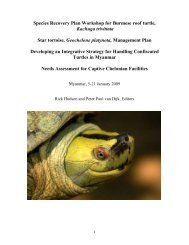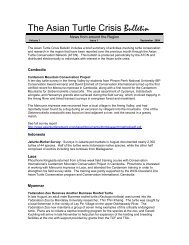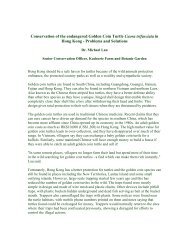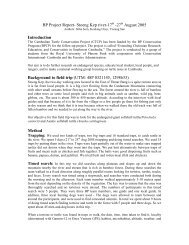Turtle Conservation Fund - Species Recovery Plan for Batagur baska
Turtle Conservation Fund - Species Recovery Plan for Batagur baska
Turtle Conservation Fund - Species Recovery Plan for Batagur baska
You also want an ePaper? Increase the reach of your titles
YUMPU automatically turns print PDFs into web optimized ePapers that Google loves.
In-Situ <strong>Conservation</strong> Needs<br />
Key <strong>Conservation</strong> Issues: Factors resulting in<br />
the decline of <strong>Batagur</strong> in the wild are summarized by Moll (1990) and Mo ll and Moll (2000), and include:<br />
1. Direct removal of animals and eggs from the wild <strong>for</strong> human food.<br />
2. Destruction of nesting beaches by sand mining.<br />
3. Creation of dams that:<br />
a. alter downstream water levels (flooding beaches when regular water releases are made<br />
during nesting season).<br />
b. destroy downstream nesting beaches (by: 1) washing<br />
them away during water releases,<br />
2) not allowing sand to wash downstream to re-<strong>for</strong>m or maintain them, and 3)<br />
depositing silt over the sand beaches making them inappropriate <strong>for</strong> nesting).<br />
c. block migration routes from estuaries to upstream nesting beaches.<br />
4. Destroy mangrove <strong>for</strong>ests that provide prime <strong>for</strong>aging habitat <strong>for</strong> this species.<br />
5. Pollution of rivers with domestic effluent and agro-industrial pollutants, particularly pesticides<br />
(P.P. van Dijk, personal communication).<br />
In situ conservation needs <strong>for</strong> <strong>Batagur</strong> should address these issues, and thus involve 1)<br />
en<strong>for</strong>cing of existing protective measures <strong>for</strong> the species, 2) establishing reserves that contain<br />
both <strong>for</strong>aging and nesting areas, including providing assistance in en<strong>for</strong>cing regulations <strong>for</strong><br />
protection in existing reserves (less of an issue than the fact that there are no adequate<br />
protected areas fully embracing an entire population’s feeding and nesting habitats) (P.P. van<br />
Dijk, personal communication), and 3) conducting public education programming in and<br />
around such reserves and in non-protected areas (where <strong>Batagur</strong> populations exist) (Moll,<br />
1990; Moll and Moll, 2000).<br />
Additionally, techniques need to be developed to successfully re-establish populations within<br />
the historic range (or bolster fragile extant populations) of this species from captive bred or<br />
head started turtles. Such techniques are not well established, and programs <strong>for</strong> other retiles<br />
employing them have received criticism as to their conservation effectiveness (Burke, 1991;<br />
Dodd and Seigel, 1991; Reinert, 1991; Seigel and Dodd, 2000). These programs must first 1)<br />
rectify the cause of decline suffered by the historic or fragile populations, and 2) employ<br />
structured, evaluative measures to access their usefulness and, if necessary, appropriately<br />
adjust their methodology. Only by utilizing sound, scientific principles in designing,<br />
implementing and evaluating release programs will we evaluate their usefulness as<br />
conservation tools.<br />
Specific Projects:<br />
1. Support of Existing Reserves:<br />
Malaysia: Peter Paul van Dijk tells us that there is a good <strong>Batagur</strong> population in the<br />
Setiu River of NE peninsular Malaysia that nests in a nominally protected area at the<br />
estuary. There’s Callagur there as well. Dino Sharma (WWF-MY) has worked on the<br />
Callagur <strong>for</strong> years and would be interested in expanding conservation and research<br />
work to <strong>Batagur</strong> if funding and dedicated staff to do the field management could be<br />
obtained. Qualifications needed are ability to speak Malay and having an<br />
understanding of turtle ecology and conservation biology. Total budget unknown.



